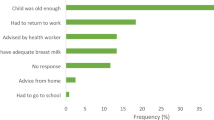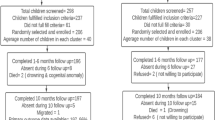Abstract
Background
In Bangladesh, only 34% of children receive minimum acceptable diets as complementary foods (CF) for appropriate age while the rest of them remain at the risk of growth faltering, micronutrient deficiency, compromised cognitive development, and increased morbidity and mortality.
Objective
The purpose of the study was to develop nutritious recipes for complementary feeding and provide necessary guidelines for improving complementary feeding practices for doctors, nutritionist and caregivers.
Methods
This qualitative study including a baseline survey and Trials of Improved Practices of recipes (TIPs) was conducted on families having 6–23 months old children selected by Multi-stage random sampling methods from 2010 to 2012 throughout seven divisions of Bangladesh. Thirty-five food recipes were developed from local food items based on the ‘WHO indicators to assess the adequacy of CF practices’ for the TIP. Thirty (30) cooked recipes were analyzed for 10 nutrients in an accredited laboratory in Bangladesh.
Results
The baseline survey found that energy density of local recipes was low and did not have the required diversity, adequacy, and nutrient density according to IYCF indicators established by WHO. The TIPs found that 28 recipes out of the 35 recipes were most acceptable by both mothers and children. A manual of improved complementary food recipes and a complementary feeding guideline has been developed with calculation of dietary diversity scores, energy and nutrient density.
Conclusion
This report will provide evidence-based practical knowledge for training and serve as nutrition education tool for nutrition practitioners, policy makers, and academicians.
This is a preview of subscription content, access via your institution
Access options
Subscribe to this journal
Receive 12 print issues and online access
$259.00 per year
only $21.58 per issue
Buy this article
- Purchase on Springer Link
- Instant access to full article PDF
Prices may be subject to local taxes which are calculated during checkout


Similar content being viewed by others
References
WHO. Guiding principles for complementary feeding of Breastfed child. Washington, D.C.: Pan American Health Organization (PAHO)/World Health Organization (WHO) Guiding; 2001.
Martorell R, Khan LK, Schroeder DG. Reversibility of stunting: epidemiological findings in children from developing countries. Eur J Clin Nutr. 1994;48:S45–S57.
WHO. Infant and young child feeding Counseling: An integrated course. Trainer’s Guide. Geneva: World health organization; 2006.
WHO. Effect of breastfeeding on infant and child mortality due to infectious diseases in less developed countries: a pooled analysis. WHO Collaborative Study Team on the Role of Breastfeeding on the Prevention of Infant Mortality. Lancet. 2000;355:451–5.
Shrimpton R, Victoria CG, De Onis M, Lima RC, Blossner M, Clugston G. Worldwide timing of growth faltering: Implications for nutrition interventions. Pediatrics 2001;107:E75.
Bangladesh Demographic and Health Survey, NIPORT, Dhaka 2014;88–91.
Dewey KG, Seth A. Systematic review of the efficacy and effectiveness of complementary feeding interventions in developing countries. Matern Child Nutr. 2008;4:24–85.
Tracking progress on childhood and maternal nutrition: UNICEF: New York. 2009 Penny ME, Creed-Kanashiro HM, Robert RC, Narro MR, Caulfield LE, Black RE. Effectiveness of an educational intervention delivered through the health services to improve nutrition in young children: a cluster randomized controlled trial. Lancet. 2005;365:1863–72.
Kabir AI. DRAFT Interim Results. Inception and interim Reports,415. Compendium of Inception and Interim Reports volume 3 Food composition and Dietary Intake (session IV) HKI/BBS/BRAC; 2010.
Guldan GS, Fan HC, Ma X, Ni ZZ, Xiang X, Tang MZ. Culturally appropriate nutrition education improves infant feeding and growth in rural Sichuan, China. J Nutr. 2000;130:1204.
Bhandari N, Mazumder S, Bahl R, Martines J, Black RE, Bhan MK. An educational intervention to promote appropriate complementary feeding practices and physical growth in infants and young children in rural Haryana, India. J Nutr. 2004;134:2342–8.
FAO. Improve the Food Security of Farming Families Affected by Volatile Food Prices. Promoting Improved Complementary Feeding with recipes, A Manual for Community Nutrition Promoters, Cambodia, FAO/EU Food Facility Project. Food and Agricultural Organization, 2011.
Mohiduzzaman M, Banu CP, Bari ML, Tukun AB, Mannan MA, Bhattacharjee L. Food Composition Table for Bangladesh, Institute of Nutrition and Food Science Centre for Advanced Research in Sciences: University of Dhaka; Dhaka, 2013.
WHO. Indicators for assessing infant and young child feeding practices, Part 1- Definitions. Washington, DC, US: World Health Organization, UNICEF, USAID, AED, UCDAVIS, IFPRI; 2008.
Dufour C, Kauffmann D, Marsland N. Enhancing the link between resailience and nutrition. Resilience for Food and Nutrition Security. 2014;107–115.
Roy SK, Fuchs GJ, Mahmud Z, Ara G, Islam S, Shafique S. Intensive nutrition education with or without supplementary feeding improves the nutritional status of moderately malnourished children in Bangladesh. J Health Popul Nutr. 2005;23:320–30.
Saxena V, Kumar P. Complementary feeding practices in rural community: A study from block Doiwala district Dehradun. Indian J Basic Appl Med Res. 2014;3:358–363.
Farah S, Karim M. Characteristics of Feeding Practices and Nutritional Status of Infants in Selected Villages at Dhamrai. Bangladesh Med Res Counc Bull. 2015;41:108–113.
Saleh F, Ara F, Hoque Md. A, Alam Md. S. Complementary Feeding Practices among Mothers in Selected Slums of Dhaka City: A Descriptive Study. J Health Popul Nutr. 2014;32:89–93.
Roy SK, Jahan K. Improvement of nutritional status among 6 to 24 months old children by nutrition education in sub-urban community of kamrangichar of Bangladesh (submitted).
Funding
This study was financed under the Research Grants Scheme (RGS) of the National Food Policy Capacity Strengthening Program (NFPCSP) Phase II. The NFPCSP is being implemented by the Food and Agriculture Organization of the United Nations (FAO) and the Food Planning and Monitoring Unit (FPMU), Ministry of Food with the financial support of EU and USAID.
Author information
Authors and Affiliations
Contributions
SKR was involved in designing the study concept and conducted the study. SK, AKMIK, KJ contributed to supervision, quality control, provided substantial advice on analysis of data, and interpretation of result. MAM was involved in editing and interpreting the manuscript and provided significant advice. LB was involved in methodology and interpretation of results and provided technical inputs. NAK was involved in data analysis and interpreting the manuscript.
Corresponding author
Ethics declarations
Conflict of interest
The authors declare no competing interests.
Ethical approval
The study was approved by Ethical Review Committee of the Bangladesh Medical Research Council (BMRC), Mohakhali, Dhaka.
Additional information
Publisher’s note Springer Nature remains neutral with regard to jurisdictional claims in published maps and institutional affiliations.
Rights and permissions
About this article
Cite this article
Roy, S.K., Jahan, K., Iqbal Kabir, A.K.M. et al. Improved recipes provide better complementary feeding in young children: findings of community-based trials in Bangladesh. Eur J Clin Nutr 76, 235–243 (2022). https://doi.org/10.1038/s41430-021-00936-z
Received:
Revised:
Accepted:
Published:
Issue Date:
DOI: https://doi.org/10.1038/s41430-021-00936-z



